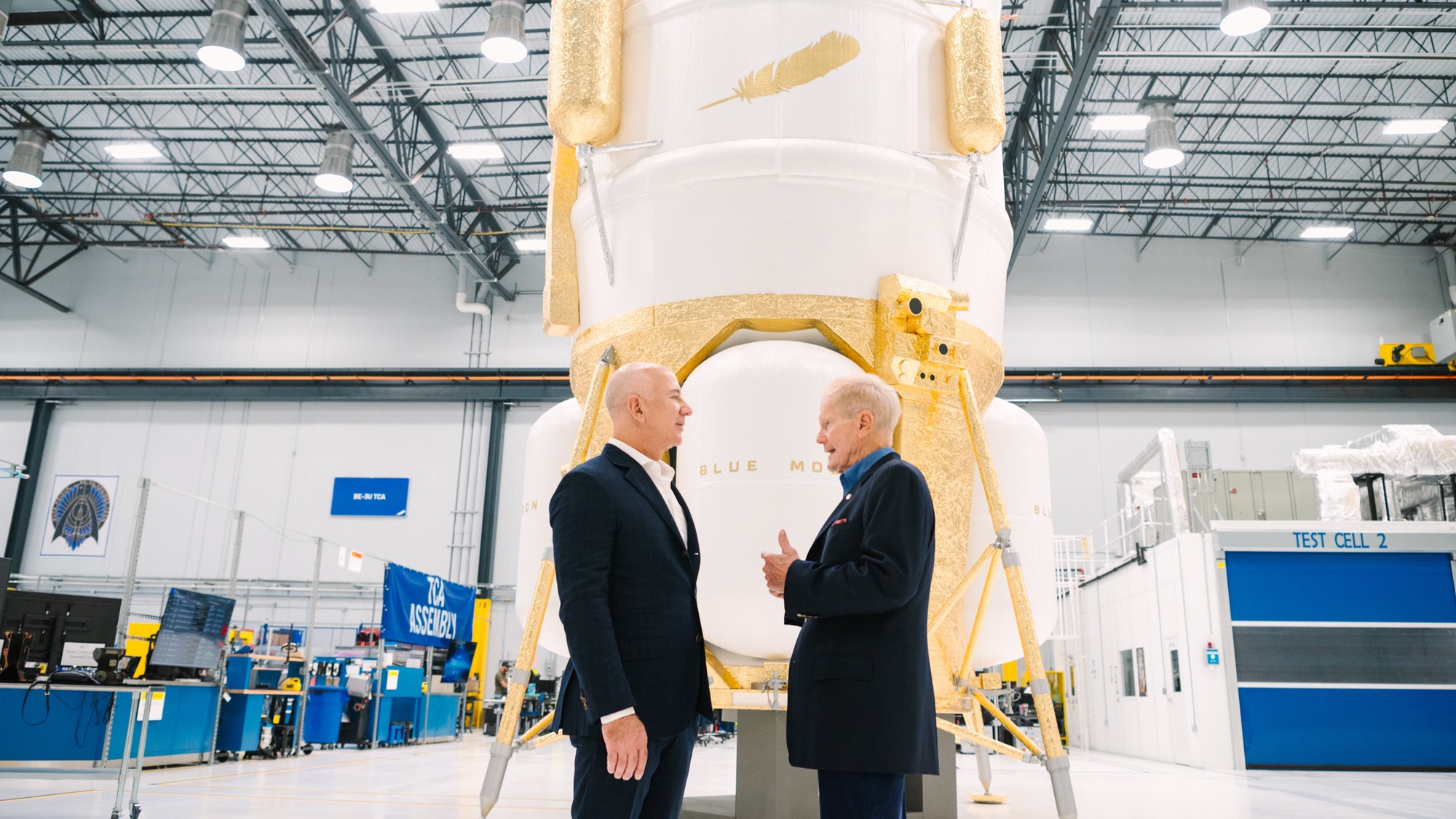Products You May Like
WASHINGTON — Blue Origin has unveiled a full-sized mockup of an uncrewed version of its Blue Moon lunar lander that will test technologies intended for a crewed version it is developing for NASA’s Artemis effort.
In social media posts Oct. 27, the company showed images of the Blue Moon Mark 1 mockup, located at an engine manufacturing facility in Huntsville, Alabama. The lander is designed to deliver three tons of cargo to the lunar surface.
The first flight of Blue Moon Mark 1 will be what the company calls the “Pathfinder Mission,” designated MK1-SN001. “MK1-SN001 proves out critical systems, including the BE-7 engine, cryogenic fluid power and propulsions systems, avionics, continuous downlink communications, and precision landing,” the company stated on its website.
Blue Origin said that future Mark 1 landers, starting with MK-SN002, will be available to carry customer payloads. Blue Origin is one of 14 companies that are part of NASA’s Commercial Lunar Payload Services program for uncrewed lunar landings. The company, though, did not state when the Pathfinder Mission or future Blue Moon Mark 1 landers might launch.
“There’s two Mark 1 lunar pathfinder landers that will fly on early flights of New Glenn,” Ben Cichy, senior director of engineering of lunar permanence at Blue Origin, said on a panel discussion at AIAA’s ASCEND conference Oct. 23, but was not more specific about launch dates.
John Couluris, senior vice president of lunar transportation at Blue Origin, said on a panel at the American Astronautical Society’s von Braun Space Exploration Symposium Oct. 25 that the Mark 1 lander was part of a continuum that includes the Mark 2 lander intended for crewed landings. NASA selected that lander as part of its Human Landing System (HLS) program in May, joining SpaceX’s Starship.
He noted that NASA’s requirements for HLS include landing within 100 meters of a designated location. Blue Origin is developing a terrain relative navigation system using lidar, tested on New Shepard suborbital flights and then later on Mark 1 landings, to get the landing precision “down to single-digit meters,” he said.
The Blue Origin announcement coincided with a social media post by NASA Administrator Bill Nelson, which showed him seeing the Blue Moon mockup with a group that included Blue Origin founder Jeff Bezos. Nelson said Blue Moon “will help ensure a steady cadence of astronauts on the Moon to live and work before we venture to Mars.”
Neither NASA nor Blue Origin disclosed when Nelson and Bezos visited the facility, but Nelson was in Huntsville Oct. 25 to speak at the von Braun Symposium.
Starship progress
The crewed version of Blue Moon is slated to be used on the Artemis 5 mission, likely no earlier than late this decade. The Artemis 3 and 4 landings will use SpaceX’s Starship.
At the von Braun Symposium, Benji Reed, senior director of human spaceflight programs at SpaceX, said a “major focus” of Starship lander development is on guidance, navigation and control technologies needed for lunar landers, as well as thermal control and power generation systems.
“The good news is we’ve been working through a number of milestones on the program and a number of technologies that we’re developing and improving on,” he said. That has benefited from a “huge wealth of experience” from other SpaceX programs, like Dragon missions to the International Space Station. “Those are going to be some of the areas that are tough, but they’re definitely things that we can accomplish as a team to make this happen.”
One of the biggest challenges, though, has been getting the integrated Starship/Super Heavy vehicle flying. Delays in that effort has led to public concerns from NASA officials about the overall development of the Starship lunar lander and, in turn, the Artemis 3 mission currently scheduled for launch in late 2025.
Jim Free, NASA associate administrator for exploration systems development, suggested in August that NASA might consider unspecified alternative missions for Artemis 3 if there were “big slips” in Starship. At that time, he said NASA had just received an updated schedule of Starship development from SpaceX, but that the agency needed “some time to digest it.”
Speaking on a panel at the von Braun Symposium Oct. 25, Free did not disclose details about that schedule and how it might affect Artemis 3. “What I’m really happy about is that they’ve shown us that end-to-end focus,” he said, including the various milestones leading up to a crewed landing.
“We need OFT 2 to go, so I hope everybody in this room is cheering on OFT 2,” he said, referring to the second orbital flight test of Starship/Super Heavy. “We need that to be successful to get us that much further down the road.”
Free said the focus for Artemis 3 should not be on Starship alone, citing work needed on Orion, which will fly with a docking ring for the first time on that mission, the Space Launch System and spacesuits being developed by Axiom Space.
“The schedule that they’ve given us shows us their thoughts on the progress to get to those dates,” he said of SpaceX’s Starship schedule. “We have to figure out how that fits into the rest of the enterprise to get to that mission date.”
